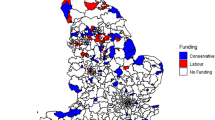Abstract
Intergovernmental grants have been conventionally explained on the basis of either equity/efficiency and/or institutional considerations. This paper seeks to model Australian intergovernmental grants by including both traditional public finance variables and public choice influences; that is, grants are used by federal government politicians to purchase political capital, thereby enhancing their own chances of reelection. The models employed in this paper are tested for six Australian states for the period 1981–82 to 1991–92 using unsystematic grant transfers. The results provide support for these public choice considerations, and highlight the importance of incorporating institutional factors and controlling for misspecification in the error structure in estimates of this type.
Similar content being viewed by others
References
Australian Bureau of Statistics. (1981–1992). Australia: Year book. Canberra: ABS Catalogue No. 1301.0.
Bradford, D.F. and Oates, W.E. (1971). Towards a predictive theory of intergovernmental grants. American Economic Review 61(2): 440–448.
Breton, A. and Scott, A. (1978). The economic constitution of federal states. Canberra: ANU Press.
Bungey, M., Grossman, P. and Kenyon, P. (1991). Explaining intergovernmental grants: Australian evidence. Applied Economics 23(4): 659–668.
Cournat, P.N., Gramlich, E.M. and Rubinfeld, D.L. (1979). The stimulative effects of intergovernmental grants: Or why money sticks where it hits. In P. Mieszkowski and W.H. Oakland (Eds.), Fiscal federalism and grants-in-aid, 5–21. Washington D.C: The Urban Institute.
Commonwealth Grants Commission (CGC). (1981–1992). Report on general revenue grant relativities (Tax-sharing relativities). Vol. I, Main report: AGPS. Canberra.
Commonwealth Grants Commission. (1981–1992). Report on general revenue grant relativities (Tax-sharing relativities). Vol. II, Methods, assessments and analysis: AGPS. Canberra.
Commonwealth Grants Commission. (1981–1992). Report on general revenue grant relativities (Tax-sharing relativities). Vol. III, Appendixes and consultants reports: AGPS. Canberra.
Davidson, R. and MacKinnon, J.G. (1981). Several tests for model specification in the presence of alternative hypotheses. Econometrica 49(3): 781–793.
Dollery, B.E. and Worthington, A.C. (1995). Federal expenditure and fiscal illusion: A test of the flypaper hypothesis in Australia. Publius: The Journal of Federalism 25(1): 23–34.
Doran, H. (1993). Testing nonnested models. American Journal of Agricultural Economics 75(1): 95–103.
Else-Mitchell, R. (1983). The establishment and operations of the commonwealth grants commission 1933–83. Reprint Series No. 58, Centre for Research on Federal Financial Relations: The Australian National University, Canberra.
Gramlich, E.M. (1977). Intergovernmental grants: A review of the empirical literature. In W.E. Oates (Ed.), The political economy of fiscal federalism, 219–239. Lexington: Lexington Books.
Grossman, P.J. (1988). A political theory of intergovernmental grants. University of Adelaide Working Paper 87–6.
Grossman, P.J. (1990). The impact of federal and state grants on local government spending: A test of the fiscal illusion hypothesis. Public Finance Quarterly 18(3): 313–327.
Grossman, P.J. (1994). A political theory of intergovernmental grants. Public Choice 78(3–4): 295–303.
Grover, J. (1989). Fiscal balance and diversity in Australian federalism. Unpublished masters dissertation, University of New England; Armidale, Australia.
Hammes, D.L. and Wills, D.T. (1987). Fiscal illusion and the grantor government in Canada. Economic Inquiry 25(4): 707–713.
Hartle, D.G. (1976). A theory of the expenditure budgetary process. Toronto: University of Toronto Press.
Hsiao, C. (1986). Analysis of panel data. Cambridge: Cambridge University Press.
Kirchgässner, G. and Schimmelpfennig, J. (1992). Closeness counts if it matters for electoral victory: Some empirical results for the United Kingdom and the Federal Republic of Germany. Public Choice 73(3): 283–299.
Kmenta, J. (1986). Elements of econometrics. New York: Macmillan.
Leyden, D.P. (1992). Donor-determined intergovernmental grants structure. Public Finance Quarterly 20(3): 321–337.
Logan, R.R. (1986). Fiscal illusion and the grantor government. Journal of Political Economy 94(6): 1304–1318.
Logan, R.R. and O'Brien, J.P. (1989). Fiscal illusion, budget maximisers and dynamic equilibrium. Public Choice 63(3): 221–235.
Macintyre, C. (1991). Political Australia: A handbook of facts. Sydney: Oxford University Press.
Mathews, R.L. (1982). Federalism in retreat: The abandonment of tax sharing and fiscal equalisation. Mimeo. Address to the Canberra Branch of the Economic Society of Australia and New Zealand, July.
Mathews, R.L. (1985). The grants commission's relativities proposals: A comment. Australian Economic Papers 24(2): 214–217.
Mathews, R.L. (1988). Specific purpose payments and the commonwealth grants commission, comments on paper by J.R.G. Butler. Mimeo. Paper read at Tenth Australian Conference of Health Economists, ANU, Canberra.
Mathews, R.L. (1994). Fiscal Equalisation — Political, Social and Economic Linchpin of Federation. Federalism Research Centre. Canberra: The Australian National University.
Oates, W.E. (1972). Fiscal federalism. New York: Harcourt Brace Jovanich.
Oates, W.E. (1979). Lump-sum intergovernmental grants have price effects. In P. Mieszkowski and W.H. Oakland (Eds.), Fiscal federalism and grants-in-aid, 23–30. Washington D.C: The Urban Institute.
Parliamentary handbook of the commonwealth of Australia. (1981–1992). Canberra: AGPS.
Thomson, N.J. (1986). Apportioning revenue sharing grants between the states: The commonwealth grants commission reports of 1981, 1982 and 1985. Economic Analysis and Policy 16(2): 169–186.
Wallis, J.J. (1991). The political economy of New Deal fiscal federalism. Economic Inquiry 29 (July): 510–524.
Winer, S.L. (1983). Some evidence on the effect of the separation of spending and taxing decisions. Journal of Political Economy 91(1): 126–140.
Wright, G. (1974). The political economy of New Dealspending: An econometric analysis. The Review of Economics and Statistics 56(1): 30–38.
Author information
Authors and Affiliations
Rights and permissions
About this article
Cite this article
Worthington, A.C., Dollery, B.E. The political determination of intergovernmental grants in Australia. Public Choice 94, 299–315 (1998). https://doi.org/10.1023/A:1017940409702
Issue Date:
DOI: https://doi.org/10.1023/A:1017940409702




